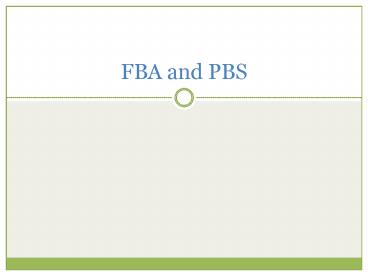FBA and PBS PowerPoint PPT Presentation
1 / 20
Title: FBA and PBS
1
FBA and PBS
2
The Competing Behavior Pathway
Maintaining Consequence Reinforce
Function
Setting Event
Setting Event Increasing Chances of
Problem behavior
Function purpose of the behavior
3
Basic Functions of Behavior
- Sensory- sensation, auditory stimuli, visual
stimuli, taste (ex wave hand, drawn to light) - Escape- avoiding a given situation( ex I dont
like to read, so I have a behavior problem during
reading) - Attention- a student gain attention when a
problem behavior is preformed (ex talking in
class- peer joke around with student) - Tangible- a behavior is preformed in order get an
item (a boy screams to get a toy)
4
Behavior Pathway Summary
Natural Reinforcing
Behaviors
Desired Increase On Task Behavior
Consequence Reinforcement and attention
Setting Event Perceived Task Difficulty
Antecedent Academic Demand, Directions
Reinforcing Consequence peers laugh, teacher
gives extra time
Problem Disruption, Off Task
Function Attention
Acceptable Be in seat with less disruption
5
Summary Statement
Antecedent Problem Behavior Maintaining
Consequence Function When given an academic
demand that is difficult or confusing to
Cassandra, she becomes off task and then
disruptive which results in gaining attention and
avoiding the task.
6
Multi-component Behavior Intervention Planning
7
(No Transcript)
8
Behavior Pathway Summary
Behaviors
Maintaining
Desired Increase On Task Behavior
Consequence Reinforcement and attention
Setting Event Perceived Task Difficulty
Antecedent Academic Demand, Directions
Consequence peers laugh, teacher gives extra time
Problem Disruption, Off Task
Acceptable Be in seat with less disruption
9
Setting Event Strategies
- These are strategies that are designed to support
students who have obvious setting events - Setting event- family arguments in the morning-
setting event strategy- counseling support - Setting event-perceived academic
difficulty-setting event strategy- one to one
tutoring prior to instruction (to build skill and
confidence)
10
Key Strategies in FBA (Stage Quiroz, 1998)
- Antecedent Strategies
- Cueing Prompting
- Self-monitoring (has elements of reinforcement
and behavior teaching) - Instructional Modifications
- Behavior Teaching
- Social Skills Instruction
- Consequence Strategies
- Differential reinforcement of Alternative
behaviors - Differential attention
- Individual or group contingencies using positive
reinforcement
11
Antecedent Strategies
- Strategies we use proactively
- prior to the behavior problem occurring
- Setting Events Strategies are also antecedent
strategies, but occur in the setting where the
setting event originates.
12
Antecedent Strategies
- Stimulus Cues- This strategy involves giving the
student clear cues, signals, reminders, or an
outline of expectations before the behavior will
be required, in order to set the student up to be
successful (i.e. The teacher says, Remember
students who are in their seats quietly will be
asked to line up for recess.).
13
Antecedent Strategies
- Instructional Modifications- This strategy
involves changing instructional presentation or
work requirements of a student in order to make
it easier for the student to successfully
complete a task or an assignment. (i.e.,
requiring only 1/2 the number of math problems,
tape recording story ideas etc.).
14
Behavior Teaching Strategies
- These strategies give a student a clear
understanding of what behaviors are expected to
be considered appropriate or successful. They are
designed to replace the problem behavior or give
the student new skills to meet their needs. - Define It, Teach It, Model It, Practice It, and
Reinforce It- regularly!
15
Behavior Teaching Strategies
- Note In order to be successful a student should
receive instruction about any strategy or
expectation utilized in a behavior support plan.
Remember, before you can expect a student to
demonstrate a behavior you must - Define It, Teach It, Model It, Practice It, and
Reinforce It- regularly!
16
Consequence Modification Strategies
- These strategies occur AFTER a behavior and serve
to increase or maintain it. Examples are - Differential Reinforcement of Alternative
Behaviors - This strategy involves the teacher
providing reinforcement for appropriate behaviors
while not responding to problem ones (i.e. The
teacher gives a desired token to the student when
she sees the student working at the assignment
rather than when the student is not working).
17
Consequence Modification Strategies
- Group Contingencies- This strategy is used when a
student CAN perform a skill but chooses not to
and the student is motivated by peer attention.
It involves creating a plan in which a group can
earn a specific reinforcer for reaching a
specific criteria (e.g. earning a pizza party
after every student has turned in all assignments
for a month.).
18
Consequence Modifications Considerations
- The best reinforcers are connected in some way to
behavior function - This may not always be possible
- Antecedent strategies and skill based (Behavior
teaching) strategies tend be more successful than
consequence strategies
19
Using FBA and PBS
- Draw and complete a Pathway for a student from
your group - Write a Summary Statement
- Antecedent, Behavior, Consequence intervention
(Setting event if you think it applicable)
20
Part II

